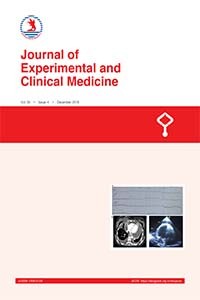Abstract
References
- 1. Mierzewska-Schmidt M, Gawecka A. Neurogenic stunned myocardium - do we consider this diagnosis in patients with acute central nervous system injury and acute heart failure? Anaesthesiol Intensive Ther 2015; 47: 175-80. 2. Woon Je Heo, Jin Ho Kang, Woo Shin Jeong, Mi Yeon Jeong, Sang Hyuk Lee, Jeong Yeun Seo, et al. Subarachnoid Hemorrhage Misdiagnosed as an Acute ST Elevation Myocardial Infarction. Korean Circ J 2012; 42: 216-9. 3. Katsanos AH, Korantzopoulos P, Tsivgoulis G, Kyritsis AP, Kosmidou M, Giannopoulos S. Electrocardiographic abnormalities and cardiac arrhythmias in structural brain lesions. Int J Cardiol 2013; 167: 328-34. 4. Yusuf SW, Bhalla KS, Champion JC. Intracranial bleed mimicking acute myocardial infarction. Intern Med J 2007; 37: 339-40. 5. Köklü E, Yüksel İÖ, Bayar N, Küçükseymen S, Arslan Ş. Subarachnoid hemorrhage that electrocardiographically mimics acute coronary syndrome: a case report. Turk Kardiyol Dern Ars 2015; 43: 730-3. 6. Murthy SB, Shah S ,Rao CP, Bershad EM, Suarez JI.Neurogenic Stunned Myocardium Following Acute Subarachnoid Hemorrhage: Pathophysiology and Practical Considerations. J Intensive Care Med. 2015 Sep;30(6):318-25. 7. Wybraniec MT, Mizia-Stec K, Krzych Ł. Neurocardiogenic injury in subarachnoid hemorrhage: A wide spectrum of catecholamin-mediated brain-heart interactions. Cardiol J. 2014;21(3):220-8.
Transient ST-segment elevation due to intracranial hemorrhage in a patient presenting with acute anterior myocardial infarction
Abstract
Neurogenic stunned myocardium (NSM) is defined as sudden onset, reversible
or irreversible myocardial injury, often mimicking acute myocardial infarction.
It is arised from an imbalance in the autonomic nervous system in various acute
brain injury situations, most commonly in the subarachnoid hemorrhage. Differ-
ent electrocardiographic abnormalities and arrhythmias are very common even
in the absence of structural heart disease. It should be carefully distinguished
from acute coronary events. We presented a case of temporary ST-segment ele-
vation after intracranial hemorrhage mimicking re-infarction that developed af-
ter thrombolytic therapy which reperfused acute anterior myocardial infarction.
Keywords
Intracranial hemorrhage Transient diffuse ST-segment elevation Neurogenic stunned myocardium
References
- 1. Mierzewska-Schmidt M, Gawecka A. Neurogenic stunned myocardium - do we consider this diagnosis in patients with acute central nervous system injury and acute heart failure? Anaesthesiol Intensive Ther 2015; 47: 175-80. 2. Woon Je Heo, Jin Ho Kang, Woo Shin Jeong, Mi Yeon Jeong, Sang Hyuk Lee, Jeong Yeun Seo, et al. Subarachnoid Hemorrhage Misdiagnosed as an Acute ST Elevation Myocardial Infarction. Korean Circ J 2012; 42: 216-9. 3. Katsanos AH, Korantzopoulos P, Tsivgoulis G, Kyritsis AP, Kosmidou M, Giannopoulos S. Electrocardiographic abnormalities and cardiac arrhythmias in structural brain lesions. Int J Cardiol 2013; 167: 328-34. 4. Yusuf SW, Bhalla KS, Champion JC. Intracranial bleed mimicking acute myocardial infarction. Intern Med J 2007; 37: 339-40. 5. Köklü E, Yüksel İÖ, Bayar N, Küçükseymen S, Arslan Ş. Subarachnoid hemorrhage that electrocardiographically mimics acute coronary syndrome: a case report. Turk Kardiyol Dern Ars 2015; 43: 730-3. 6. Murthy SB, Shah S ,Rao CP, Bershad EM, Suarez JI.Neurogenic Stunned Myocardium Following Acute Subarachnoid Hemorrhage: Pathophysiology and Practical Considerations. J Intensive Care Med. 2015 Sep;30(6):318-25. 7. Wybraniec MT, Mizia-Stec K, Krzych Ł. Neurocardiogenic injury in subarachnoid hemorrhage: A wide spectrum of catecholamin-mediated brain-heart interactions. Cardiol J. 2014;21(3):220-8.
Details
| Primary Language | English |
|---|---|
| Subjects | Health Care Administration |
| Journal Section | Case Report |
| Authors | |
| Publication Date | November 18, 2019 |
| Submission Date | December 30, 2017 |
| Acceptance Date | January 10, 2018 |
| Published in Issue | Year 2018 Volume: 35 Issue: 4 |
Cite

This work is licensed under a Creative Commons Attribution-NonCommercial 4.0 International License.


